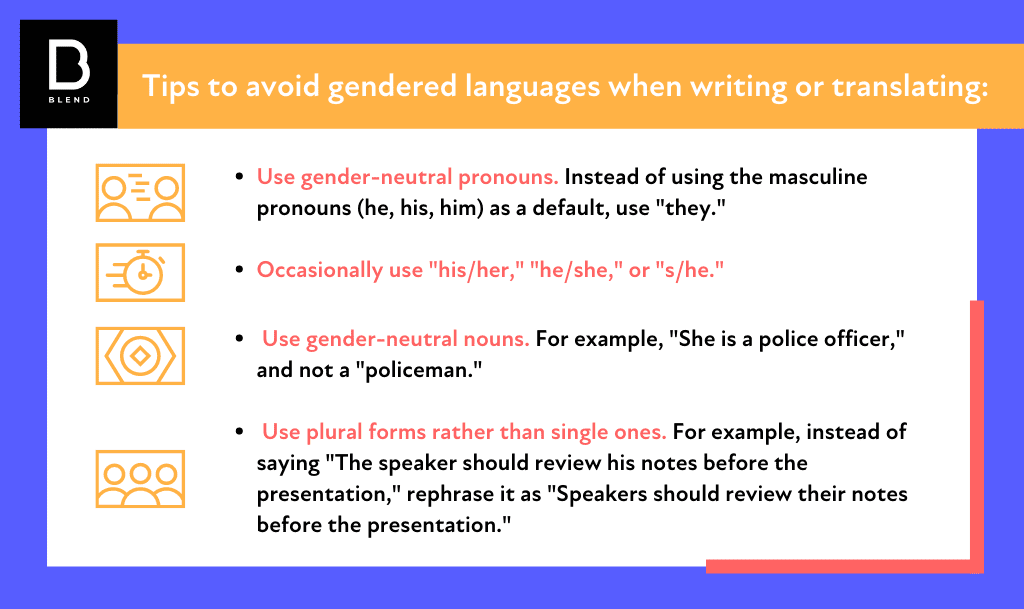Corinne Sharabi
Corinne is the Social Media and Content Lead at BLEND. She is dedicated to keeping global business professionals up to date on all things localization, translation, language and culture.

Gendered language consists of words and phrases that ascribe particular gender-based attributes or feature an inclination to one sex. While some languages are notable for gendering nouns or even objects, others are grammatically genderless. However, virtually all have some cultural or practical gendered aspects. In today’s evolving societal and business landscape, where gendered phrasing is being scrutinized and reevaluated, it’s important that you familiarize yourself with the concept, both for communication in your native language or multilingual content for your company.
Localizing your marketing campaign, or new app involves not only being aware of cultural norms and customs, but also using native-speaking linguists to translate your words. With several thousand languages spoken around the world, all differing from each other in vocabulary and structure, this is a big task. Have you, however, considered how the language your customers see and read affects their perception of your product, especially as regards gender?
Gendered language examples include English and Spanish. In the English language, masculine nouns and pronouns are automatically used if the gender of the subject is unclear or changeable, while in Spanish, even if there is only one male among a group of women (no matter how small or large), all language referring to that group is masculine. When looking at languages, what quickly becomes apparent is how androcentric (focused on the male) they are—how they can even disadvantage women.
Gendered language refers to the use of words and phrases that reinforce societal distinctions between genders, typically categorizing individuals as either masculine or feminine. This linguistic phenomenon is prevalent in many languages, where nouns, pronouns, adjectives, and even verbs are often marked with gender-specific markers.
For example, in languages like Spanish or French, nouns are assigned grammatical genders (masculine or feminine), influencing the forms of accompanying words. Gendered language can inadvertently perpetuate stereotypes and reinforce unequal power dynamics. Efforts to address this issue include using gender-neutral language, which avoids assumptions about a person’s gender, promoting inclusivity and equality.
Advocates argue that adopting such language is essential for promoting a more inclusive and just society that respects diverse gender identities.
Most of us take our use of language for granted, but the impact of gendered languages can be powerful, with few (if any) societies using non-gendered language. Examining a society’s use of gendered language can be a powerful tool for seeing how that society views men and women. Some countries such as France and Spain use gendered noun languages, with words (often arbitrarily) being assigned as feminine or masculine. This grammatical gendering can have a subtle impact on our thinking, but more powerful is the way assumptions and stereotypes are perpetuated by our use of masculine and feminine words and phrases.
A powerful example of this is the US Declaration of Independence, a historical document of its time. This states that “… all men are created equal …” When written, it referred explicitly to men. In more recent years, schoolchildren have been taught that the word “men” includes both males and females.
No one could argue now, however, that women don’t play a powerful role at all levels of American society. This means that we should no longer consider the words “man” and “men” as being synonymous with both masculine forms of sexes. Interestingly, this male-dominated usage has not always been the case.
Historically, the pronoun “they” was used in literature for centuries as a non-gendered way of speaking about both men and women. It was only in the 19th century that grammarians insisted on the sex-definite “he.” A strange choice when a powerful woman ruled over a great part of the world!
While becoming less common, specific genders are often still given specific roles such as in “Employees and their wives are invited” rather than “Employees and their partners are invited,” or “Mothers can benefit from the school’s pastoral program” rather than “Parents can benefit from the school’s pastoral program.” Referring to members of female sports teams as “girls” is infantilizing, while the use of “lady” over “woman” has historic overtones of lower social status.
It is not only specific words that can generate gender bias but word order as well. When two people are mentioned in a sentence, semantic hierarchical meaning is often applied. This makes the first person mentioned more important and often receives more attention. In androcentric cultures, men are usually mentioned first—husband and wife, men and women, boys, and girls. This gendered language reinforces stereotypes, and in the marketing world, it can be offputting to women, maybe disinclining them to engage with your product or service.
A Ted Talk by Lera Boroditsky (2018), “How languages shape the way we think,” gives a fascinating insight into gendered language that demonstrates its power. She refers to the fact that different languages give different genders to the same nouns. For example, in German, the word for “bridge” is feminine, whereas in Spanish it is masculine. Studies show that German speakers describe bridges as “elegant” and “beautiful,” while Spanish speakers refer to their more physical, masculine qualities such as strength and length. In the second half of 2021, women represented 49.58% of the world’s population, and if we believe these women deserve social and employment equality with men, this should be reflected in our language use. This is particularly important if you’re localizing products and services for different markets around the globe.
If you recognize that gender-inclusive language is important for localization, there are a number of ways you can address the issue.

As can be seen, the language of gender can affect our perceptions of unspecified gender in many ways. If you want your product, communications, or marketing materials to appeal equally to both women and men then it’s vital that your localization process uses gender-inclusive language.
At BLEND, we have a full range of localization services and professional translation services ready to help your business grow and attract customers whatever their gender.
What our customers are saying